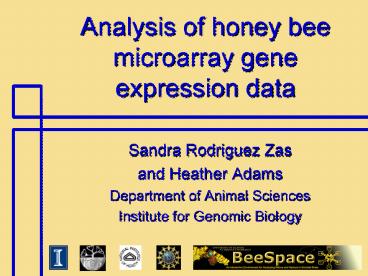Analysis of honey bee microarray gene expression data - PowerPoint PPT Presentation
1 / 17
Title:
Analysis of honey bee microarray gene expression data
Description:
Beehive: integrated microarray data workflow. Spotted microarray technology ... NIH Beehive data repository. http://stagbeetle.animal.uiuc.edu/Beehive3.0 ... – PowerPoint PPT presentation
Number of Views:219
Avg rating:3.0/5.0
Title: Analysis of honey bee microarray gene expression data
1
Analysis of honey bee microarray gene expression
data
- Sandra Rodriguez Zas
- and Heather Adams
- Department of Animal Sciences
- Institute for Genomic Biology
2
Outline
- Microarray technology
- Experimental design
- Normalization and analysis
- Robinsons lab experiments
- Ismail et al. (4 treatments)
- Sen Sarma et al. (2 behaviors)
- Alaux et al. (2-3 treatments/age)
- Beehive integrated microarray data workflow
3
Spotted microarray technology
- Two samples hybridized to the same array
- Each sample labeled with a different dye
4
Microarray designs
- (Yang and Speed, 2002)
5
Considerations
- Microarray gene expression experiments
- Goal is to detect interesting genes
- Can have potentially complex designs
- Produce vast amounts of data
- Exhibit technical sources of variation
- Require thousands of analyses
6
Filtering and Normalization
- Removal of unreliable spots and microarray
elements - Weak or variable
- Normalization removal of systematic technical
noise - Dye effects
- Microarray effects
- Combination of replicate spots
7
Analysis
- Linear mixed effects models
- dye factor(s) covariate(s) interactions
microarray other blocking factors - Multiple-test adjustment of P-values
- Consideration of specific contrasts among factor
levels - P-value, fold change, observation num.
- Clustering, PCA, DA
8
Sen Sarma Ismail experiments
- 9K cDNA microarray platform
- Sen Sarma
- One-day old nurse and forager bees
- 4 species (AC, AD, AF, AM)
- direct comparison, dye swap, 44 microarrays
- 3 colonies, 2 pools/behavior/species
- Ismail
- 4 treatments (1wk, 2wk, CC, treated)
- 3 colonies, 60 microarrays
- direct comparison, partial loop and dye swap
9
Results (P lt 0.0001)
- Sen Sarmas experiment number of elements with
differential expression - Ismails experiment 13 elements
10
Alaux et al. experiments
- 13K oligo microarray platform
- Experiment 1 QMP vs NT (2 ages)
- direct comparison
- 32 arrays, 2 colonies, 2 ages, 4 bees/treatment
- Experiment 2 BP, Brood, control (2 ages)
- 4 loop designs/age/colony
- 48 arrays, 2 colonies, 2 ages, 4 bees/treatment
11
Alauxs results
- Number of elements with differential expression
(P lt 0.0001 1.25 fold change) - 6 elements QMP vs NT _at_ Age 3
- 22 elements QMP vs NT _at_ Age 4
- 18 5, 1, 4 BP-Br, BP-C, Br-C _at_ Age 5
- 20 3, 3, 3 BP-Br, BP-C, Br-C _at_ Age 15
12
Functional annotation of results
- Sen Sarma
- lipid transport and metabolism ion transport /
homeostasis/defense response - nervous system development/mesoderm and ectoderm
development/cell proliferation/cell-cell
signaling/regulation of protein transport
/nucleic acid binding and metabolism - Ismail
- neuromuscular junction development/synaptic
growth/ dendrite development/ axonogenesis /eye
development - transmission of nerve impulse/acetyltransferase
activity/drug transporter activity/amino acid
metabolism - Alaux
- 2 muscle proteins response to virus
mitochondrial ribosomal protein mating behavior,
pupal development, pigmentation
13
NIH-NIGMS Beehive system
- http//stagbeetle.animal.uiuc.edu/Beehive3.0
- Web-based public resource
- Facilitates and supports storage, analysis and
interpretation of microarray gene expression data
- Integrated, one-stop, workflow including
- Simplified uploading of microarray experiments
- Storage/download MIAME compliant experiments
- Normalization and analyze data
- Visualization of results
- Query of results
- Integrated annotations
14
NIH Beehive data repositoryhttp//stagbeetle.anim
al.uiuc.edu/Beehive3.0
Login, data uploading and, MIAME specification
15
NIH Beehive analysis/visualizationhttp//stagbeet
le.animal.uiuc.edu/Beehive3.0
Normalization, clustering and analysis
specification
16
NIH Beehive query/annotationhttp//stagbeetle.ani
mal.uiuc.edu/Beehive3.0
Query of results and annotations
17
Acknowledgements
- Heather Adams
- Bruce Southey
- Younhee Ko
- Brandon Smith
- Gene Robinson and lab
- Charlie Whitfield
- Chris Elsik
- NSF FIBR
- NIH NIGMS































